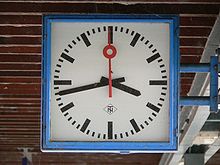Minute jump clock
A minute jump clock is a clock in which the minute hand does not advance continuously, but jumps to the next minute mark every 60 seconds . It is mostly a slave clock that is controlled by a master clock every minute.
use
Most public clocks are minute jump clocks controlled by a master clock, of which the station clock is the most common.
In some analogue quartz watches that do not have a second hand, the minute hand jumps every 20 or 30 seconds, so they are probably jump clocks, but by definition not minute jump clocks. With purely mechanical wristwatches , the minute jump is almost only used as an additional complication in exclusive luxury or enthusiast watches because of the considerable mechanical effort involved .
Advantages and disadvantages
On the one hand, minute jump clocks are extremely simply constructed as slave clocks. Because the minute hand remains at the position of the last completed minute , this can also be clearly read. On the other hand, it is not possible to determine how far the current minute has advanced without an additional second hand.
Railway station clock with second hand
In order to be able to check the minute at train stations, a second hand is added to the station clocks of most national railway companies. The Swiss train station clock contains a special solution with the second hand that moves ahead and stops briefly every full minute.

